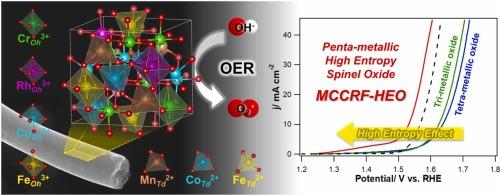High-Entropy Spinel Oxide (Mn0.5Co0.9Cr0.9Rh0.5Fe0.2)O4 Nanotubes: Cr-Driven Disorder Engineering for Enhanced Oxygen Evolution Reaction
IF 6.3
2区 材料科学
Q2 CHEMISTRY, PHYSICAL
引用次数: 0
Abstract
Spinel-structured high-entropy oxides (HESOs) have emerged as remarkable electrocatalysts for oxygen evolution reactions (OER) due to their intrinsic compositional tunability and structural complexity. In this study, spinel-type high-entropy oxide (Mn0.5Co0.9Cr0.9Rh0.5Fe0.2)O4 nanotubes (MCCRF-HEO) were synthesized via simple electrospinning and following calcination process to serve as a superior alkaline OER catalysts. The incorporation of Cr critically promoted the development of a unique nanostructure, where crystalline HESO nanoparticles are uniformly embedded within an amorphous nanotube matrix. The MCCRF-HEO demonstrated excellent electrocatalytic activity for OER in 1.0 M KOH, including lower overpotential (303.8 mV at 10 mA cm−2) and smaller Tafel slope (69.6 mV dec−1) than commercial Ir-based catalysts. In addition, it exhibited outstanding long-term stability under 24-hour continuous operation under alkaline conditions. The results highlight that the synergistic effects arising from strategic incorporation of heterogenous metal cations facilitate structural disorder and entropy stabilization, thereby optimizing catalytic performance in high-entropy spinel systems.

高熵尖晶石氧化(Mn0.5Co0.9Cr0.9Rh0.5Fe0.2)O4纳米管:cr驱动无序工程增强析氧反应
尖晶石结构的高熵氧化物(HESOs)由于其固有的成分可调性和结构复杂性而成为出氧反应(OER)的重要电催化剂。本研究通过简单静电纺丝和煅烧工艺合成了尖晶石型高熵氧化物(Mn0.5Co0.9Cr0.9Rh0.5Fe0.2)O4纳米管(MCCRF-HEO),作为一种优良的碱性OER催化剂。Cr的掺入极大地促进了独特纳米结构的发展,其中结晶HESO纳米颗粒均匀地嵌入非晶纳米管基质中。MCCRF-HEO在1.0 M KOH条件下对OER表现出优异的电催化活性,包括较低的过电位(10ma cm−2时303.8 mV)和较小的Tafel斜率(69.6 mV dec−1)。此外,在碱性条件下24小时连续运行也表现出良好的长期稳定性。结果表明,在高熵尖晶石体系中,多相金属阳离子的加入所产生的协同效应促进了结构紊乱和熵稳定,从而优化了催化性能。
本文章由计算机程序翻译,如有差异,请以英文原文为准。
求助全文
约1分钟内获得全文
求助全文
来源期刊

Journal of Alloys and Compounds
工程技术-材料科学:综合
CiteScore
11.10
自引率
14.50%
发文量
5146
审稿时长
67 days
期刊介绍:
The Journal of Alloys and Compounds is intended to serve as an international medium for the publication of work on solid materials comprising compounds as well as alloys. Its great strength lies in the diversity of discipline which it encompasses, drawing together results from materials science, solid-state chemistry and physics.
 求助内容:
求助内容: 应助结果提醒方式:
应助结果提醒方式:


